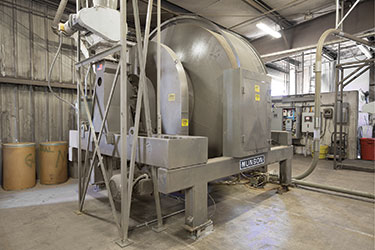Operators at Willamette Valley Co. say the 140 cu ft (4 cu m) Rotary Batch Mixer delivers uniform blends in high volumes that customers demand.
Mixer inlet (foreground) receives material from feed hoppers above.
From the mixer discharge the blend is pneumatically transferred to the bag filling equipment.
Mixing flights lift, cut, fold and tumble the material achieving blend uniformity in one to three minutes.
Plywood adhesive blend consists of fine mesh bark powder from the Western Red Alder tree, along with other wood material.





